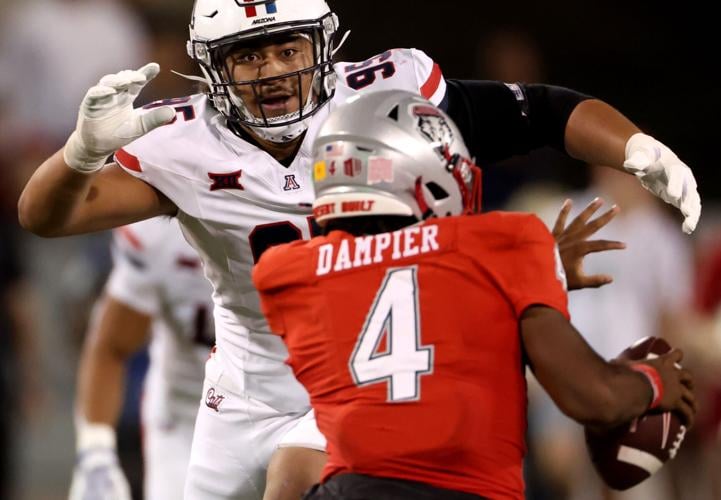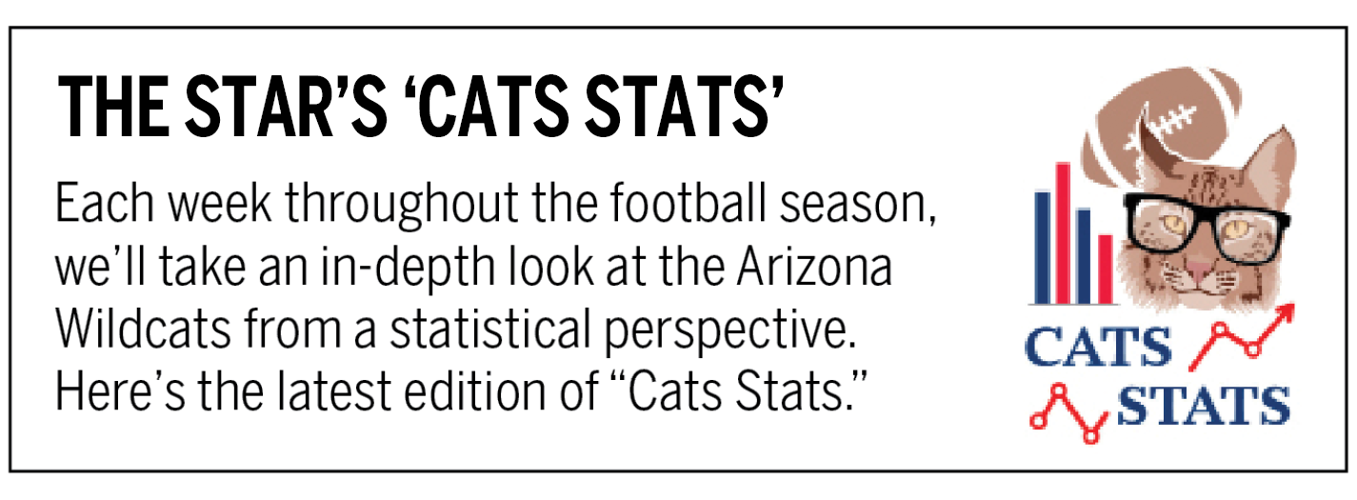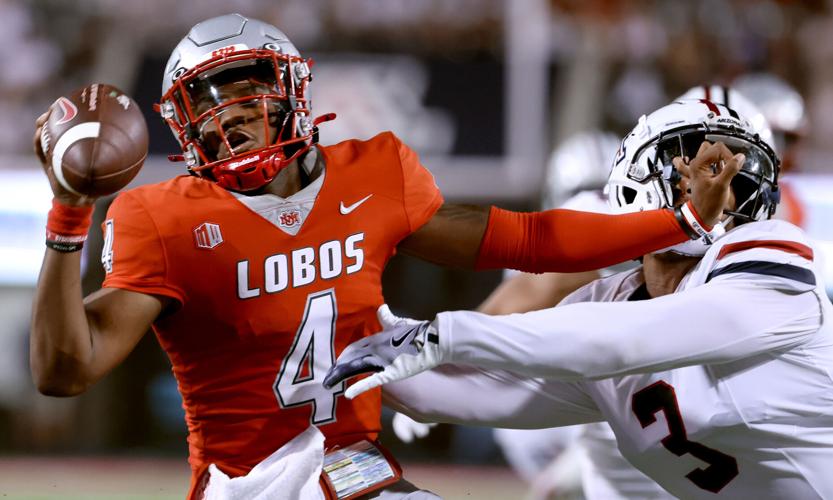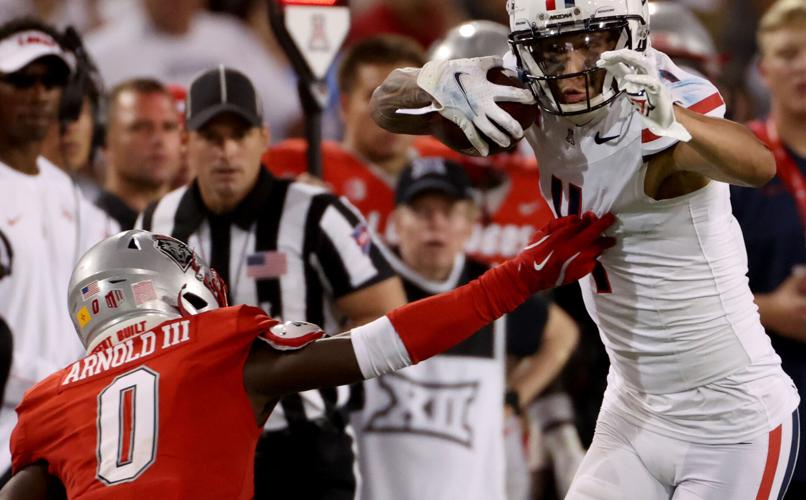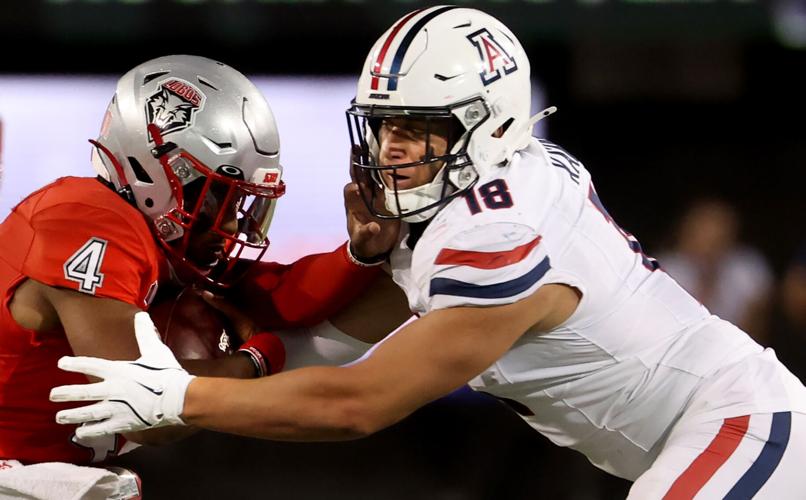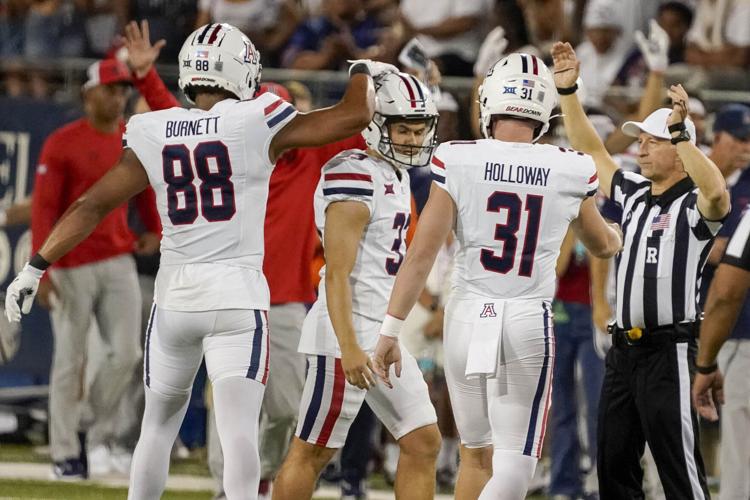Arizona didn’t need to use every club in its bag to defeat New Mexico in the season opener last week. But we still learned a lot about the Wildcats in Week 1, especially when it comes to personnel usage.
In this week’s “Cats Stats,” ahead of Saturday’s nonconference home game against NAU, we’ll examine some of the tendencies that emerged against the Lobos.
Using data from our colleagues at Pro Football Focus, we’ll look at rotations on defense and formations on offense and try to determine what might stick moving forward. We’ll start on the defensive side of the ball.

So. Many. Defensive. Linemen.
Before the season, D-line coach Joe Seumalo said he wanted to play 12 defensive linemen. That seemed like an ambitious, even unrealistic, objective.

Arizona defensive lineman Keanu Mailoto flushes New Mexico quarterback Devon Dampier out of the pocket and into a scramble on Saturday. Dampier hurt UA with his arm and legs.
Then, in the opener, Seumalo one-upped himself. Thirteen defensive linemen played at least nine snaps vs. New Mexico.

New Mexico quarterback Devon Dampier, left, stiff-arms his way out of the reach of Arizona defensive lineman Tre Smith to avoid a sack in the Wildcats’ season opener on Aug. 31 in Tucson.
More likely than not, that number will shrink when Arizona visits Kansas State in a Top 25 matchup next Friday.
“It’s early in the season. Some of this is evaluation,” defensive coordinator Duane Akina said. “We’re encouraged with our defensive front. (But) you want to develop some depth at that position, because in this conference — and this has changed from years gone by when I was last there — there’ll be times they’ll be playing 80-90 snaps.
“We played 87 snaps (including penalties) this last week. That’s a lot of football.”
Fifteen defensive linemen, including stand-up edge rushers, appeared in games for Arizona last season. But only 10 played 150 or more snaps, while five played fewer than 50.
Tre Smith (59 snaps) and Ta’ita’i Uiagalelei (56) played by far the most snaps against the Lobos and appeared to be the anchors of the Wildcats’ rebuilt defensive front. Uiagalelei started at defensive tackle but also played end. The 6-4, 280-pounder has proved to be a valuable chess piece in his two-plus seasons in Tucson.

Arizona linebacker Kamuela Ka’aihue, right, grabs New Mexico quarterback Devon Dampier on his scramble up the middle.
Linebackers lacking
It was a different story at linebacker. Only three linebackers were credited with any defensive snaps, and two of them played almost the whole game: Taye Brown (83) and Jacob Manu (78).
It was definitely surprising to see Brown play that much. The sophomore earned a starting spot in summer and kept it during training camp. But this past Saturday marked his first career start, and fellow sophomore Kamuela Ka’aihue — who played only six snaps — also made a positive impression during the offseason.
“We felt like we should have subbed him more,” Akina said of Brown. “And Manu. That’s a position that we have to develop more depth.”
PFF tagged Brown with a team-high three missed tackles. Manu was charged with two.
Look for Ka’aihue to get more snaps this week. Jared Small and Justin Flowe could get some looks as well.
Akina also suggested that safety Dalton Johnson could serve as a pseudo-linebacker in a dime package, a role Martell Irby played at times last season. Arizona did not show that formation against New Mexico.

Arizona wide receiver Tetairoa McMillan, right, sidesteps New Mexico cornerback Bobby Arnold III for a few more yards after a catch in Saturday’s game.
Slot machine
We could have written this entire piece about Tetairoa McMillan’s record-setting performance. But T-Mac doesn’t like hogging the spotlight, so we’ll focus on just one aspect — where he lined up.
Out of the 29 pass snaps that he played, the junior receiver lined up in the slot nine times. That rate of 31% was significantly higher than the previous two seasons (23.7%).
McMillan inflicted major damage from the slot, catching five of six targets for 192 yards and two touchdowns. The yards surpassed his season total out of the slot as a freshman (188), and the TDs matched his total as a sophomore.
What’s to be gained by putting T-Mac in the slot vs. lining him up out wide?
“It’s a matchup,” receivers coach Bobby Wade said. “Being able to move him around, it allows us to see what they want to do. ... It’s also something that he can do.
“When you have a player like that, you want to move him around and be able to get him in different spots. And he’s comfortable with it. He plays well inside and outside. So we expect to continue to move him around.”
Some teams will have their best cornerback shadow McMillan wherever he goes. Every team will try to be physical with him at the line and will deploy safety help whenever possible. The more McMillan moves around the formation, the more difficult those countermeasures become.
11 vs. 12
For most of the game, Arizona used two personnel groupings on offense: 11 (one running back, one tight end, three receivers) and 12 (one back, two tight ends, two receivers). The Wildcats also sprinkled in a jumbo package featuring a sixth offensive lineman and a fullback.
Arizona averaged 2.33 wide receivers per offensive snap and 1.49 tight ends. The latter suggests Arizona used 12 personnel roughly half the time.
Aside from the jumbo package — an almost automatic run in short-yardage situations — the Wildcats’ offensive formations didn’t tip their intent.

Arizona tight end Keyan Burnett (88) and long snapper Justin Holloway (31) congratulate kicker Tyler Loop (33) after a field goal during the Wildcats’ win over New Mexico on Aug. 31 in Tucson.
Tight end Keyan Burnett played 42 snaps. Twenty-two were pass plays (including one where he blocked) and 20 were run plays. Burnett also lined up in the slot six times.
Fellow tight end Sam Olson played 24 snaps. Sixteen were pass plays (including three where he blocked) and eight were run plays. Olson lined up in the slot five times and out wide once.
Roberto Miranda was the tight end used in the jumbo package, so his numbers skew toward the run game: 18 total snaps, four pass plays, 14 run plays.
Total package
One last note about last week’s game: Arizona’s 57 offensive plays were an unusually low total.
Only twice last year did the Wildcats run fewer than 62 plays: the opener vs NAU (53) and the penultimate regular-season game vs. Utah (57). They averaged 66.3.
What led to that low play count vs. New Mexico? For starters, Arizona had a ton of big plays, including two completions of 60-plus yards from Noah Fifita to McMillan and a 51-yard touchdown run by Quali Conley.

New Mexico safety Christian Ellis gets the only touch on Arizona running back Quali Conley as the scoots to a touchdown in the third quarter Saturday in Tucson.
The Wildcats were so explosive that they ventured into the red zone only two times. They made at least three trips to the red zone in 12 of 13 games last season and averaged 4.4.
Arizona also had a difficult time getting New Mexico off the field. The Lobos converted 6 of 13 third downs and 2 of 2 fourth downs.
Additionally, the Wildcats lost a possession when a New Mexico punt bounded off the backside of blocker Rex Haynes late in the third quarter.


